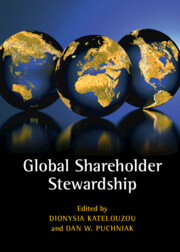Book contents
- Endorsements
- Global Shareholder Stewardship
- Global Shareholder Stewardship
- Copyright page
- Dedication
- Contents
- Figures
- Tables
- Contributors
- Foreword
- Acknowledgements
- Abbreviations
- Part I Foundations
- Part II Jurisdictions
- 4 Shareholder Stewardship in the Netherlands
- 5 Capitalist Stakeholders
- 6 Institutional Investor Stewardship in Italian Corporate Governance
- 7 The Danish Stewardship Code
- 8 Stewardship Norwegian-Style
- 9 Stewardship and Shareholder Engagement in Germany
- 10 The Japanese Stewardship Code
- 11 Korea’s Stewardship Code and the Rise of Shareholder Activism
- 12 The Assessment of Taiwan’s Shareholder Stewardship Codes
- 13 Stewardship in the Hong Kong International Financial Centre
- 14 Singapore’s Embrace of Shareholder Stewardship
- 15 Institutional Investor Stewardship in Malaysia
- 16 The Thai Institutional Investors Stewardship Code and Its Implementation
- 17 Shareholder Stewardship in India
- 18 Institutional Investors in China
- 19 Stewardship and Collective Action
- 20 Stewardship Principles in Canada
- 21 The Uncertain Stewardship Potential of Index Funds
- 22 Encouraging Sustainable Investment in South Africa
- 23 Stewardship in Kenya
- 24 The Brazilian Stewardship Framework
- Part III Comparisons
- Index
19 - Stewardship and Collective Action
The Australian Experience
from Part II - Jurisdictions
Published online by Cambridge University Press: 28 April 2022
- Endorsements
- Global Shareholder Stewardship
- Global Shareholder Stewardship
- Copyright page
- Dedication
- Contents
- Figures
- Tables
- Contributors
- Foreword
- Acknowledgements
- Abbreviations
- Part I Foundations
- Part II Jurisdictions
- 4 Shareholder Stewardship in the Netherlands
- 5 Capitalist Stakeholders
- 6 Institutional Investor Stewardship in Italian Corporate Governance
- 7 The Danish Stewardship Code
- 8 Stewardship Norwegian-Style
- 9 Stewardship and Shareholder Engagement in Germany
- 10 The Japanese Stewardship Code
- 11 Korea’s Stewardship Code and the Rise of Shareholder Activism
- 12 The Assessment of Taiwan’s Shareholder Stewardship Codes
- 13 Stewardship in the Hong Kong International Financial Centre
- 14 Singapore’s Embrace of Shareholder Stewardship
- 15 Institutional Investor Stewardship in Malaysia
- 16 The Thai Institutional Investors Stewardship Code and Its Implementation
- 17 Shareholder Stewardship in India
- 18 Institutional Investors in China
- 19 Stewardship and Collective Action
- 20 Stewardship Principles in Canada
- 21 The Uncertain Stewardship Potential of Index Funds
- 22 Encouraging Sustainable Investment in South Africa
- 23 Stewardship in Kenya
- 24 The Brazilian Stewardship Framework
- Part III Comparisons
- Index
Summary
The growth of shareholder stewardship codes around the globe reflects a belief that greater engagement by institutional shareholders improves corporate decision-making and protects against excessive risk-taking. In theory, there is considerable sense in shareholders undertaking their stewardship activities collectively, to leverage their power, pool resources and share costs, making stewardship more feasible and less speculative. This chapter examines collective action in Australia, which constitutes a nuanced corporate governance practice. Evidence indicates that investors do not routinely engage in direct forms of collective action, preferring to leverage their collective influence through intermediary organizations that undertake behind-the-scenes engagement activities for investors. The nuanced image emerging from the Australian experience highlights that collective action by institutional shareholders is by no means a simple governance phenomenon. This chapter explores the implications of this insight for how securities and takeover laws apply to collective action, and how the issuers of stewardship codes frame their codes’ expectations regarding collective action.
Keywords
- Type
- Chapter
- Information
- Global Shareholder Stewardship , pp. 417 - 436Publisher: Cambridge University PressPrint publication year: 2022
- 1
- Cited by



